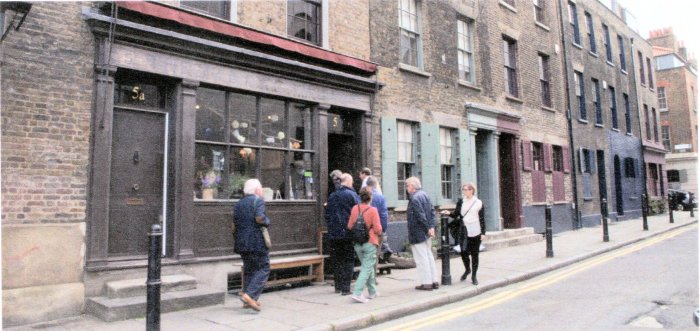Vist to Spitalfields - TrustNews Sept 15
“A huge, heavy galleon of white Portland stone anchored among the red brick Queen Anne houses of the weavers”
That is how John Betjeman described the Hawksmoor church of Christ Church Spital?elds and it is more or less what we found when 23 trust members went on a tour organised by lain Patton in late May.
It was a hot day and the coach trip into London was pretty tedious but that was all forgotten when we arrived at Christ Church and met our wonderful guide Charlie de Wet. She is clearly a force of nature - local resident, chair of the Huguenots of Spitalfield, friend of Christ Church, City of London Red Badge guide — and no doubt much more. It was delightful to follow her through the streets of Spitalfield where she knew so much of the history, so many of the buildings and their inhabitants, past and present. We could not have wished for a more knowledgeable and enthusiastic advocate for the area.
Christ Church is one of the “Queen Anne churches" funded by an Act of Parliament in 1711 [by a coal tax] to build 50 new churches in newly populated areas on the fringes of London. Six of them were designed by Nicholas Hawksmoor.
The history of Spitalfields is the history of immigration in many ways: Huguenots in the 17th and 18th centuries, Jews in the 18th and 19th centuries, Bangladeshis in the 20th century, Somalis most recently. That history is reflected in the buildings.
By 1960, Christ Church was derelict and in danger of demolition. It was saved by voluntary action and determination. Since then over £10 million has been raised for restoration and it is now a flourishing parish church, community hub and concert venue. Most recently, the Friends of Christ Church have restored the 1735 Richard Bridges organ. The exterior still dominates the street view on all sides. The interior is elegant and dramatic.
ln the late 17th century, following the Revocation of the Edict of Nantes, some 50,000 French Protestants, known as Huguenots, relocated to England because Louis XIV had ended a century of religious toleration. Many of them were silk weavers and they settled in Spitalfields because it was outside the guild restrictions of the City of London.
Charlie led us through Fournier Street and other beautiful terraces built for these master silk weavers and their workers. Many are now beautifully restored. We went into Brick Lane and an amazing local supermarket full of exotic fruit, vegetables and fish. Then we strolled through Spitalfields market which is now foodie heaven and full of arts and crafts. No time to browse though as our next stop was the Synagogue in Sandy's Row. We were warmly welcomed by Rose Edmands and other members of the congregation who gave us a lively account of the development of their community.
This synagogue had started life in 1766 as an Huguenot chapel but by mid 19th century the silk industry was in decline and the Huguenots had long moved on. Jews from many different places were now heading to East London and in 1867 the chapel was leased by a small tightly knit group of Ashkenazi Jews from Amsterdam. They were economic refugees unlike those from Eastern Europe but rather than join existing synagogues they preferred to set up their own - which started life as a mutual aid and burial society. Just like the Anglicans and the Huguenots before them, their numbers have since diminished but they have arrested that decline and it is still a vibrant place of worship. It is also a fascinating architectural mixture - a spacious Georgian chapel reconfigured for different patterns of worship which produce a beautiful and harmonious whole and reflects a significant part of the history of Spitalfields.
After a delicious lunch at the Water Poet, we headed for 18 Folgate Street.

Dennis Severs’ house is one of those Georgian weavers‘ houses - but it has not been restored in the conventional sense. Dennis Severs was an American captivated by the area who spent 20 years recreating this house as a time capsule. The 18th century rooms have been arranged as though they are still in use, giving a still life drama complete with sounds and smells and far removed from some glossy Hollywood conception of “Jane Austen land”.
This was an extraordinary experience and much more engrossing than I had expected. l found the dilapidated weavers’ loft on the top floor the most compelling part but the whole enterprise was convincing and an interesting imaginative journey.
Then it was back to Christ Church and the coach home to Winchester. Winchester is also a Huguenot city as you will see if you check the links below and other Hampshire Huguenots include the Portals of Laverstoke - there is a free lecture at Hampshire Record Office on 24 September about Henri Portal. His paper mills at Laverstoke have recently gained a new lease of life as the Bombay Sapphire gin distillery and can be visited with the added advantage of a cocktail bar at the end.
We are hugely grateful to Charlie de Wet for her enthusiastic and erudite leadership throughout the day, to Rose and her colleagues at the synagogue, and to lain Patton for all the dull organisation which got us there and back. Many of us have already resolved to return to Spital?elds to enjoy more that the area has to offer and I list some links which may assist.
Huguenotsofspitalfields.org
sandysrow.org.uk
dennissevershouse.co.uk
www.spitalfieldsmusic.org.uk
www.christchurchspitalfields.org.uk
www3.hants.gov.uk/archives
distillery.bombaysapphire.com
